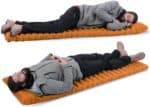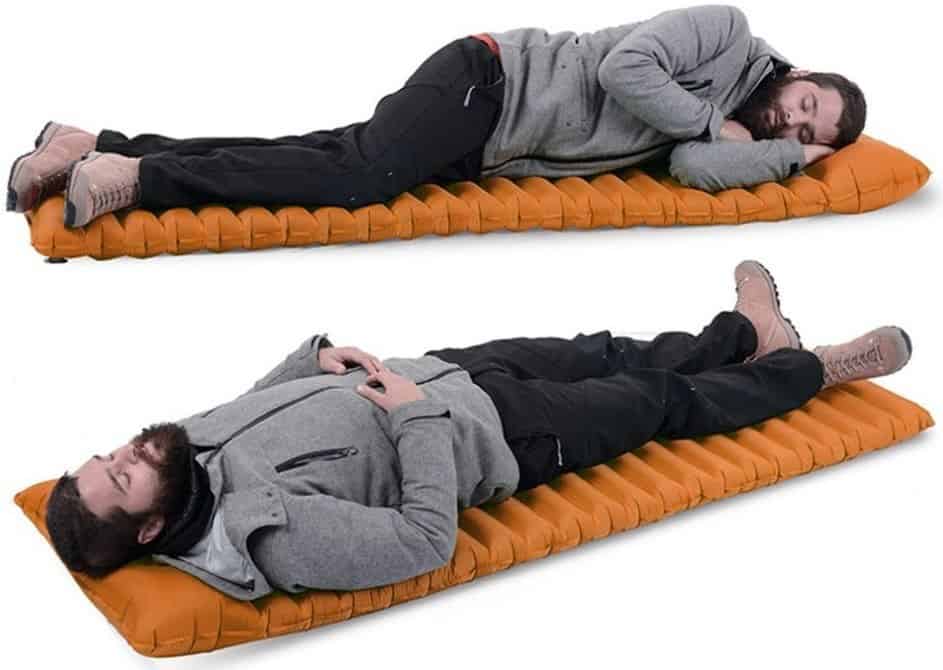For the ‘budget hiker’ the sleeping pad and bag are no doubt the most expensive items. Such a pad need cost no more than US$13! If your expeditions are likely to only occur in the warmer months you can improve the insulative ability of a cheaper pad enough by simple expedients. In this post I noted that you can purchase an entry level pad from approx A$20. A search like this on Aliexpress will find you a range of other options under from US$4 , $10.28 to US$20. Some of these at least will be inflatable pads up tpo 4” thickand possibly under 400 grams. They should have an approx R-rating of 2.0 which should be fine for summer.
PS: Punctures and running repairs. Use this or this.

Pictured $10.28 inflatable mat from Naturehike.
To increase that rating, you could add a cheap (from $5.86) foam pad under. A ½” closed foam pad should have an R-rating of approximately 1.0. It need not go all the way under you. You could shorten it to torso length (but you risk having cold legs if the temperature really falls. You lose more heat where your body exerts the mst pressure so that all forms of heat loss (conduction, radiation and convection) are accentuated – but obviously in this case conduction. The same thing (pressure) is why your ultralight ‘waterproof’ groundsheet might leak through at your hips. The extra pressure there may have the effect of increasing the ‘head’ to over the rating (in millimeters) of the might sheet.
Some people will argue that you should place the foam pad on top of the inflatable on the theory that the stiffness of the foam will reduce the compression of the inflatable thus leading to greater insulation than the other way around. I believe that the pad on the ground will perform better (and will certainly be more comfortable) as it will much more greatly reduce the conduction from the inflatable pad which is where you would otherwise lose the most heat.
Another way you can increase the R-rating of this cheap pad is to place it (but not yourself- because of teh condensation) inside a space blanket bag. These are very cheap (from around US$2.67) and weigh less than 90 grams. Because it will reduce radiative heat loss (particularly if you are also using the foam pad) this should add about another 1.0 to that R-rating. Now you have an R-rating of 4.0 enough for a night down to -5C or so, fine for three season use. The total cost, from $13 to say $40!
If you need your pad to be warmer still try making up a fern or brush bed 2″-3″ deep before you lay the mat down.
To that US$13 pad I would add a DIY Cosco Quilt (US$20ea), a budget backpack (US$17.99), and an ultra cheap tent (A$50). Some Polycro for a groundsheet (US$4.23) and a cheap poncho and a DIY stove nearly completes your kit.
NB: Too many people are ‘gear junkies’ or ‘gear snobs. Grandma Gatewood completed the AT (twice – at 67 the first time!) equipped with a shower curtain as a raincoat (& etc). I’m sure John Colter and Daniel Boone crossed the continent with considerably less – though they may have carried a rifle.
BTW: Those ‘Laybags’ are getting ridiculously cheap. US6.79!
See Also:
http://www.theultralighthiker.com/3f-tents/
http://www.theultralighthiker.com/ultralight-hiking-on-a-budget/
http://www.theultralighthiker.com/budget-pack-mods/
http://www.theultralighthiker.com/pine-down-blanket/
http://www.theultralighthiker.com/cosco-quilt/
http://www.theultralighthiker.com/brawnys-tarptent/

